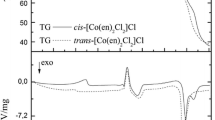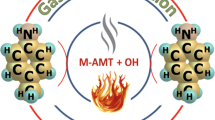Abstract
The changes of enthalpy for the reactions
-
(1)
Sn(c)+2I2(c)+4165 CS2(l)=[SnI4; 4165 CS2] (sol.),
-
(2)
SnI4(c)+4223 CS2(l)=[SnI4; 4223 CS2] (sol.)
At 298,15 K have been found by solution calorimetry to be ΔH 1=(−46.7±0.3) and ΔH 2=(+3.2±0.1) kcal Mol−1, resp. Neglecting the heat of dilution which is approximately zero these values give ΔH f o (SnI4; c; 298 K)=9−49.9±0.4) kcal Mol−1 for the enthalpy of formation of SnI4.
From existing literature data the standard entropy is calculated to beS o(SnI4; c; 298 K)=69,7 cal Mol−1 K−1 giving ΔG f o (SnI4; c; 298 K)=−50,5 kcal Mol−1 for the corresponding change in theGibbs free energy.
Zusammenfassung
Die Enthalpieänderungen bei 298,15 K für die Reaktionen
-
(1)
Sn(c)+2 J2(c)+4165 CS2(l)=[SnJ4; 4165 CS2] (Lsg.)
-
(2)
SnJ4(c)+4223 CS2(l)=[SnJ4; 4223 CS2] (Lsg.)
Wurden kalorimetrisch bestimmt. Sie betragen ΔH 1=(−46,7±0,3) und ΔH 2=(+3,2±0,1) kcal Mol−1. Unter Vernachlässigung der Verdünnungswärme, welche angenähert Null ist, ergibt sich daraus die Bildungsenthalpie des SnJ4: ΔH f o (SnJ4; c; 298 K)=(−49,9±0,4) kcal Mol−1.
Aus den vorhandenen Literaturdaten berechnet man für die Standardentropie des SnJ4 S o (SnJ4; c; 298 K)=69,7 cal Mol−1 K−1, woraus ΔG f o (SnJ4; c; 298 K)=−50,5 kcal Mol−1 für die Freie Bildungsenthalpie folgt.
Similar content being viewed by others
Literatur
R. G. Feber, Heats of Dissociation of Gaseous Halides, USAEC Rept. No. LA-3164 (1964).
T. Moeller undD. C. Edwards, Inorg. Synthesis4, 119 (1953).
E. A. McDermott, J. Amer. Chem. Soc.33, 1963 (1911).
M. G. Räder, Z. anorg. allgem. Chem.130, 326 (1923).
W. L. Jolly, The Synthesis and Characterization of Inorganic Compounds, p. 91. New York: Englewood Cliffs. 1970.
J. Mikler undE. Bauernfeind, (Mh. Chem.103, 116 (1972).
S. U. Pickering, J. Chem. Soc. [London]53, 865 (1888);P. Waentig, Z. physik. Chem.68, 513 (1909).
S. R. Gunn, J. Chem. Thermodyn.3, 19 (1971).
D. D. Wagman, W. H. Evans, V. B. Parker, I. Halow, S. M. Bailey undR. H. Schumm, Selected Values of Chemical Thermodynamic Properties, NBS Technical Note 270-3, Washington (D.C.) 1968.
G. N. Lewis undM. Randall, Thermodynamics (rev. byK. S. Pitzer undL. Brewer), 2nd (stud. ed.) ed. p. 175. New York (Mexico): 1965.
A. Kabesh undR. S. Nyholm, J. Chem. Soc. [London]1951, 3245.
K. K. Kelley, U.S. Bur. Mines Bull. 584 (1960).
E. Sirtl, Z. Naturforschg.21a, 2001 (1966).
H. Schäfer, H. Bruderreck undB. Morcher, Z. anorg. allgem. Chem.352, 122 (1967).
R. T. Sanderson, Chemical Bonds and Bond Energy, p. 189. New York-London: 1971.
L. Brewer, G. R. Somayajulu undE. Bracket, Chem. Rev.63, 111 (1963).
Author information
Authors and Affiliations
Additional information
Mit 1 Abbildung
Rights and permissions
About this article
Cite this article
Mikler, J. Die Bildungsenthalpie von SnJ4 . Monatshefte für Chemie 104, 376–388 (1973). https://doi.org/10.1007/BF00903102
Received:
Issue Date:
DOI: https://doi.org/10.1007/BF00903102




